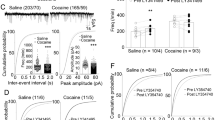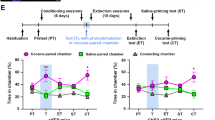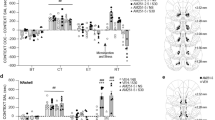Abstract
Many studies support a perspective that addictive drugs usurp brain circuits used by natural rewards, especially for the dopamine-dependent reinforcing qualities of both drugs and natural rewards. Reinstated drug seeking in animal models of relapse relies on glutamate spillover from cortical terminals synapsing in the nucleus accumbens core (NAcore) to stimulate metabotropic glutamate receptor5 (mGluR5) on neuronal nitric oxide synthase (nNOS) interneurons. Contrasting the release of dopamine that is shared by sucrose and drugs of abuse, reinstated sucrose seeking does not induce glutamate spillover. We hypothesized that pharmacologically promoting glutamate spillover in the NAcore would mimic cocaine-induced adaptations and potentiate cued reinstatement of sucrose seeking. Inducing glutamate spillover by blocking astroglial glutamate transporters (GLT-1) had no effect on reinstated sucrose seeking. However, glutamate release probability is negatively regulated by presynaptic mGluR2/3, and sucrose reinstatement was potentiated following mGluR2/3 blockade. Potentiated sucrose reinstatement by mGluR2/3 blockade was reversed by antagonizing mGluR5, but reinstated sucrose seeking in the absence of mGluR2/3 blockade was not affected by blocking mGluR5. In cocaine-trained rodents mGluR5 stimulation reinstates drug seeking by activating nNOS, but activating mGluR5 did not promote reinstated sucrose seeking, nor was potentiated reinstatement after mGluR2/3 blockade reduced by blocking nNOS. However, chemogenetic activation of nNOS interneurons in the NAcore reinstated sucrose seeking. These data indicate that dysregulated presynaptic mGluR2/3 signaling is a possible site of shared signaling in drug seeking and potentiated reinstated sucrose seeking, but that downregulated glutamate transport and subsequent activation of nNOS by synaptic glutamate spillover is not shared.
Similar content being viewed by others
Log in or create a free account to read this content
Gain free access to this article, as well as selected content from this journal and more on nature.com
or
References
Ahmed SH, Guillem K, Vandaele Y (2013). Sugar addiction: pushing the drug-sugar analogy to the limit. Curr opin clin nutr metab care 16: 434–439.
Baker DA, McFarland K, Lake RW, Shen H, Tang XC, Toda S et al (2003). Neuroadaptations in cystine-glutamate exchange underlie cocaine relapse. Nat Neurosci 6: 743–749.
Baker DA, Xi ZX, Shen H, Swanson CJ, Kalivas PW (2002). The origin and neuronal function of in vivo nonsynaptic glutamate. J neurosci 22: 9134–9141.
Baptista MA, Martin-Fardon R, Weiss F (2004). Preferential effects of the metabotropic glutamate 2/3 receptor agonist LY379268 on conditioned reinstatement versus primary reinforcement: comparison between cocaine and a potent conventional reinforcer. J neurosci 24: 4723–4727.
Bechara A (2005). Decision making, impulse control and loss of willpower to resist drugs: a neurocognitive perspective. Nat Neurosci 8: 1458–1463.
Bossert JM, Gray SM, Lu L, Shaham Y (2006). Activation of group II metabotropic glutamate receptors in the nucleus accumbens shell attenuates context-induced relapse to heroin seeking. Neuropsychopharmacology 31: 2197–2209.
Bridges R, Lutgen V, Lobner D, Baker DA (2012). Thinking outside the cleft to understand synaptic activity: contribution of the cystine-glutamate antiporter (System xc-) to normal and pathological glutamatergic signaling. Pharmacol Rev 64: 780–802.
Brown RM, Kupchik YM, Spencer S, Garcia-Keller C, Spanswick DC, Lawrence AJ et al (2015). Addiction-like synaptic impairments in diet-induced obesity. Biol Psychiatry 81: 797–806.
Carelli RM, Ijames SG, Crumling AJ (2000). Evidence that separate neural circuits in the nucleus accumbens encode cocaine versus ‘natural’ (water and food) reward. J neurosci 20: 4255–4266.
Carr KD (2016). Nucleus accumbens AMPA receptor trafficking upregulated by food restriction: an unintended target for drugs of abuse and forbidden foods. Curr Opin Behav Sci 9: 32–39.
Counotte DS, Schiefer C, Shaham Y, O'Donnell P (2014). Time-dependent decreases in nucleus accumbens AMPA/NMDA ratio and incubation of sucrose craving in adolescent and adult rats. Psychopharmacology (Berl) 231: 1675–1684.
D'Ascenzo M, Fellin T, Terunuma M, Revilla-Sanchez R, Meaney DF, Auberson YP et al (2007). mGluR5 stimulates gliotransmission in the nucleus accumbens. Proc Natl Acad Sci USA 104: 1995–2000.
Danbolt NC (2001). Glutamate uptake. Prog Neurobiol 65: 1–105.
Griffin WC 3rd, Haun HL, Hazelbaker CL, Ramachandra VS, Becker HC (2014). Increased extracellular glutamate in the nucleus accumbens promotes excessive ethanol drinking in ethanol dependent mice. Neuropsychopharmacology 39: 707–717.
Grueter BA, McElligott ZA, Robison AJ, Mathews GC, Winder DG (2008). In vivo metabotropic glutamate receptor 5 (mGluR5) antagonism prevents cocaine-induced disruption of postsynaptically maintained mGluR5-dependent long-term depression. J Neurosci 28: 9261–9270.
Hayashi Y, Nishio M, Naito Y, Yokokura H, Nimura Y, Hidaka H et al (1999). Regulation of neuronal nitric-oxide synthase by calmodulin kinases. J Biol Chem 274: 20597–20602.
Huang CC, Yeh CM, Wu MY, Chang AY, Chan JY, Chan SH et al (2011). Cocaine withdrawal impairs metabotropic glutamate receptor-dependent long-term depression in the nucleus accumbens. J neurosci 31: 4194–4203.
Knackstedt LA, Melendez RI, Kalivas PW (2010a). Ceftriaxone restores glutamate homeostasis and prevents relapse to cocaine seeking. Biol Psychiatry 67: 81–84.
Knackstedt LA, Moussawi K, Lalumiere R, Schwendt M, Klugmann M, Kalivas PW (2010b). Extinction training after cocaine self-administration induces glutamatergic plasticity to inhibit cocaine seeking. J neurosci 30: 7984–7992.
Kreitzer AC, Malenka RC (2005). Dopamine modulation of state-dependent endocannabinoid release and long-term depression in the striatum. J Neurosci 25: 10537–10545.
LaLumiere RT, Kalivas PW (2008). Glutamate release in the nucleus accumbens core is necessary for heroin seeking. J neurosci 28: 3170–3177.
Luscher C, Huber KM (2009). Group 1 mGluR-dependent synaptic long-term depression: mechanisms and implications for circuitry and disease. Neuron 65: 445–459.
Luscher C, Malenka RC (2011). Drug-evoked synaptic plasticity in addiction: from molecular changes to circuit remodeling. Neuron 69: 650–663.
McFarland K, Lapish CC, Kalivas PW (2003). Prefrontal glutamate release into the core of the nucleus accumbens mediates cocaine-induced reinstatement of drug-seeking behavior. J neurosci 23: 3531–3537.
Montiel T, Camacho A, Estrada-Sanchez AM, Massieu L (2005). Differential effects of the substrate inhibitor l-trans-pyrrolidine-2,4-dicarboxylate (PDC) and the non-substrate inhibitor DL-threo-beta-benzyloxyaspartate (DL-TBOA) of glutamate transporters on neuronal damage and extracellular amino acid levels in rat brain in vivo. Neuroscience 133: 667–678.
Moran MM, McFarland K, Melendez RI, Kalivas PW, Seamans JK (2005). Cystine/glutamate exchange regulates metabotropic glutamate receptor presynaptic inhibition of excitatory transmission and vulnerability to cocaine seeking. J neurosci 25: 6389–6393.
Moussawi K, Kalivas PW (2010). Group II metabotropic glutamate receptors (mGlu(2/3)) in drug addiction. Eur J Pharmacol 639: 115–122.
Moussawi K, Zhou W, Shen H, Reichel CM, See RE, Carr DB et al (2011). Reversing cocaine-induced synaptic potentiation provides enduring protection from relapse. Proc Natl Acad Sci USA 108: 385–390.
Mulholland PJ, Chandler LJ, Kalivas PW (2016). Signals from the fourth dimension regulate drug relapse. Trends neurosci 39: 472–485.
Oginsky MF, Goforth PB, Nobile CW, Lopez-Santiago LF, Ferrario CR (2016a). Eating 'junk-food' produces rapid and long-lasting increases in NAc CP-AMPA receptors: implications for enhanced cue-induced motivation and food addiction. Neuropsychopharmacology 41: 2977–2986.
Oginsky MF, Maust JD, Corthell JT, Ferrario CR (2016b). Enhanced cocaine-induced locomotor sensitization and intrinsic excitability of NAc medium spiny neurons in adult but not in adolescent rats susceptible to diet-induced obesity. Psychopharmacology (Berl) 233: 773–784.
Oldenziel WH, Dijkstra G, Cremers TI, Westerink BH (2006). In vivo monitoring of extracellular glutamate in the brain with a microsensor. Brain Res 1118: 34–42.
Olive MF (2009). Metabotropic glutamate receptor ligands as potential therapeutics for addiction. Curr Drug Abuse Rev 2: 83–98.
Paxinos G, Franklin KBJ. The Mouse Brain in Stereotaxic Coordinates, 2nd edn. Academic Press: New York, 1997..
Peng XX, Ziff EB, Carr KD (2011). Effects of food restriction and sucrose intake on synaptic delivery of AMPA receptors in nucleus accumbens. Synapse 65: 1024–1031.
Peters J, Kalivas PW (2006). The group II metabotropic glutamate receptor agonist, LY379268, inhibits both cocaine- and food-seeking behavior in rats. Psychopharmacology (Berl) 186: 143–149.
Porter JT, McCarthy KD (1997). Astrocytic neurotransmitter receptors in situ and in vivo. Prog Neurobiol 51: 439–455.
Rameau GA, Chiu LY, Ziff EB (2004). Bidirectional regulation of neuronal nitric-oxide synthase phosphorylation at serine 847 by the N-methyl-D-aspartate receptor. J Biol Chem 279: 14307–14314.
Rao PS, Sari Y (2012). Glutamate transporter 1: target for the treatment of alcohol dependence. Curr med chem 19: 5148–5156.
Robbe D, Alonso G, Duchamp F, Bockaert J, Manzoni OJ (2001). Localization and mechanisms of action of cannabinoid receptors at the glutamatergic synapses of the mouse nucleus accumbens. J Neurosci 21: 109–116.
Rothstein JD, Dykes-Hoberg M, Pardo CA, Bristol LA, Jin L, Kunci RW et al (1996). Knockout of glutamate transporters reveals a major role for astroglial transport in excitotoxicity and clearance of glutamate. Neuron 16: 675–686.
Schmidt HD, Schassburger RL, Guercio LA, Pierce RC (2013). Stimulation of mGluR5 in the accumbens shell promotes cocaine seeking by activating PKC gamma. J Neurosci 33: 14160–14169.
Schoepp D, Conn P (1993). Metabotropic glutamate receptors in brain function and pathology. TiPS 14: 13–20.
Schreiber LR, Odlaug BL, Grant JE (2013). The overlap between binge eating disorder and substance use disorders: diagnosis and neurobiology. J behav addict 2: 191–198.
Schultz W (2011). Potential vulnerabilities of neuronal reward, risk, and decision mechanisms to addictive drugs. Neuron 69: 603–617.
Scofield MD, Heinsbroek JA, Gipson CD, Kupchik YM, Spencer S, Smith AC et al (2016a). The nucleus accumbens: mechanisms of addiction across drug classes reflect the importance of glutamate homeostasis. Pharmacol Rev 68: 816–871.
Scofield MD, Li H, Siemsen BM, Healey KL, Tran PK, Woronoff N et al (2016b). Cocaine self-administration and extinction leads to reduced glial fibrillary acidic protein expression and morphometric features of astrocytes in the nucleus accumbens core. Biol Psychiatry 80: 207–215.
Sinclair CM, Cleva RM, Hood LE, Olive MF, Gass JT (2012). mGluR5 receptors in the basolateral amygdala and nucleus accumbens regulate cue-induced reinstatement of ethanol-seeking behavior. Pharmacol biochem behav 101: 329–335.
Smith AC, Scofield MD, Heinsbroek JA, Gipson CD, Neuhofer D, Roberts-Wolfe DJ et al (2017). Accumbens nNOS interneurons regulate cocaine relapse. J neurosci 37: 742–756.
Sun W, McConnell E, Pare JF, Xu Q, Chen M, Peng W et al (2013). Glutamate-dependent neuroglial calcium signaling differs between young and adult brain. Science 339: 197–200.
Tallaksen-Greene SJ, Kaatz KW, Romano C, Albin RL (1998). Localization of mGluR1a-like immunoreactivity and mGluR5-like immunoreactivity in identified populations of striatal neurons. Brain Res 780: 210–217.
Tomasi D, Volkow ND (2013). Striatocortical pathway dysfunction in addiction and obesity: differences and similarities. Crit Rev Biochem Mol Biol 48: 1–19.
Tronci V, Vronskaya S, Montgomery N, Mura D, Balfour DJ (2010). The effects of the mGluR5 receptor antagonist 6-methyl-2-(phenylethynyl)-pyridine (MPEP) on behavioural responses to nicotine. Psychopharmacology (Berl) 211: 33–42.
Tukey DS, Ferreira JM, Antoine SO, D'Amour JA, Ninan I, Cabeza de Vaca S et al (2013). Sucrose ingestion induces rapid AMPA receptor trafficking. J neurosci 33: 6123–6132.
Wang X, Moussawi K, Knackstedt L, Shen H, Kalivas PW (2013). Role of mGluR5 neurotransmission in reinstated cocaine-seeking. Addict Biol 18: 40–49.
Wolf ME (2010). The Bermuda Triangle of cocaine-induced neuroadaptations. Trends Neurosci 33: 391–398.
Acknowledgements
The authors would like to thank Dr Louk Vanderschuren and Dr Kate Reissner for helpful discussions, Dr Angie M. Cason for useful comments on rat sucrose self-administration, Dr Heather A. Boger for allowing us to perform the rat locomotor measurement using her equipment, Dr William C. Griffin III for allowing the use of the mice locomotor boxes, as well as Meghan Grandal for her help with the nNOS mouse behavior.
Author information
Authors and Affiliations
Corresponding authors
Additional information
Supplementary Information accompanies the paper on the Neuropsychopharmacology website
Supplementary information
Rights and permissions
About this article
Cite this article
Bobadilla, AC., Garcia-Keller, C., Heinsbroek, J. et al. Accumbens Mechanisms for Cued Sucrose Seeking. Neuropsychopharmacol 42, 2377–2386 (2017). https://doi.org/10.1038/npp.2017.153
Received:
Revised:
Accepted:
Published:
Issue date:
DOI: https://doi.org/10.1038/npp.2017.153
This article is cited by
-
Astrocyte ensembles manipulated with AstroLight tune cue-motivated behavior
Nature Neuroscience (2025)
-
Amyloid-β oligomers in the nucleus accumbens decrease motivation via insertion of calcium-permeable AMPA receptors
Molecular Psychiatry (2022)
-
Behavioral and accumbens synaptic plasticity induced by cues associated with restraint stress
Neuropsychopharmacology (2021)
-
Cocaine and sucrose rewards recruit different seeking ensembles in the nucleus accumbens core
Molecular Psychiatry (2020)
-
Effects of adenosine A2A receptor antagonists on cocaine-induced locomotion and cocaine seeking
Psychopharmacology (2019)



